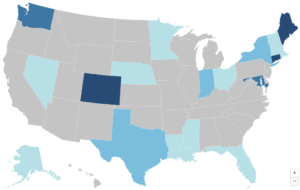
In early September, CHIR Assistant Analysis Professor Christine Monahan testified earlier than the Texas Home Insurance coverage Committee on outpatient facility charge billing and potential reforms. The Texas legislature is presently making ready for its 89th legislative session subsequent spring, and the latest listening to will play a crucial function in shaping laws to return.
Christine’s feedback to the committee comply with. A corresponding slide deck is out there right here.
At CHIR, we examine personal medical insurance and well being care markets, conduct authorized and coverage evaluation, and supply technical help to federal and state policymakers, regulators and stakeholders on a spread of matters. With the assist of West Well being, I and a number of other members of the CHIR workforce have been learning outpatient facility charge billing for the previous two years. Now we have carried out a number of dozen interviews with on the bottom stakeholders, reviewed present legal guidelines and pending laws at each the state and federal ranges, written a number of analyses, and, most not too long ago, revealed a collection of maps reporting on our evaluation of the legal guidelines in all 50 states and the District of Columbia associated to outpatient facility charge billing.
Step one to understanding facility charge billing is to grasp that there are two sorts of claims usually used to invoice for medical companies: an expert invoice (the CMS-1500) and the power invoice (the UB-04). Should you obtain care at an unbiased supplier follow, the supplier who handled you’ll submit an expert invoice to your insurer. This invoice, in concept, covers their time and labor in addition to any follow overhead prices, like nursing employees, lease, and tools and provides. Then again, if you happen to obtain care at a hospital outpatient division, usually talking any skilled who handled you, in addition to the hospital, will every submit separate payments. Any skilled payments ought to simply cowl the supplier’s time and labor, whereas the hospital invoice – or facility charge – ostensibly covers overhead prices.
What counts as hospital overhead and what else goes right into a facility charge is difficult, nonetheless. As you’ll count on, a facility charge usually will cowl the overhead prices associated to the affected person go to for which it’s being billed, together with the nurses or assist employees concerned and any tools and provides. As a result of hospital outpatient departments want to satisfy further licensure and regulatory necessities, they probably even have some extra prices that don’t apply to unbiased settings.
As well as, a facility charge is more likely to cowl different hospital overhead prices. A few of these are crucial and fascinating companies on the inhabitants degree, however not associated to the care delivered to the affected person who’s getting billed. For instance, facility charges may assist fund issues like hospital emergency companies, or 24/7 staffing and safety on the hospital, despite the fact that the affected person was on the facility throughout regular enterprise hours and didn’t want any emergency care or they went to a very separate, off-campus facility ten miles from the hospital campus and emergency room. Hospital overhead prices may embody issues of extra debatable worth – from excessive CEO salaries, to costly art work or gourmand meals companies, to, I child you not, film manufacturing studios. All of this stuff could also be thought-about hospital “prices” that sufferers might be requested to pay via a facility charge.
It is usually necessary to know that different components, unrelated to the price of care or different bills a hospital has, additionally play a giant function in figuring out how a lot a hospital payments for and will get paid by insurers, together with historic billing patterns and market energy. Significantly as hospitals and well being programs get greater, and vertically combine, they’ve rather more energy than your solo doctor or unbiased group follow to demand increased reimbursement when negotiating with insurers.
So, when financial consultants evaluate the costs paid for a similar companies at hospital outpatient departments and unbiased doctor workplaces, they discover a lot increased costs in hospital settings. Chemotherapy is one instance from the Committee for a Accountable Federal Funds. A affected person going for weekly chemotherapy visits would see, on common, a 2.7-fold distinction in value in the event that they switched from an unbiased follow to a hospital outpatient division. And, in fact, they’re typically not those making that alternative to modify – somewhat, sooner or later in the course of therapy they might go into the identical workplace constructing as at all times, for a similar care as at all times, and are available away with a invoice that’s greater than $400 increased than what they’re used to as a result of a hospital acquired their follow and transformed it to a hospital outpatient division.

It’s this latest historical past of aggressive hospital acquisition of outpatient practices that’s driving the difficulty at the moment. Facility charge billing will not be a novel follow, however it’s extra frequent than it was following years of vertical integration the place hospitals are buying or constructing their very own outpatient doctor practices and clinics. Certainly, one of many causes hospitals and well being programs have considerably expanded their possession and management over outpatient doctor practices over the previous decade or so, is so they may cost this second invoice and enhance their revenues.
One other probably purpose we’re listening to about facility charge billing extra now are inadequacies in insurance coverage protection. Because the hospital business will emphasize, sufferers more and more are coming in with excessive deductible well being plans which depart them uncovered to extra expenses, together with facility charges. The hospitals are usually not incorrect in stating this hole, however it’s best understood as a symptom of the higher downside of rising costs.
Increased spending on outpatient care from facility charge expenses is growing the price of medical insurance for all of us: sufferers and customers who enroll in medical insurance, employers who’re sponsoring insurance coverage for his or her employees and paying greater than 70-80% of their well being plan premiums, and taxpayers who closely subsidize the personal medical insurance market. Economist Stephen Parente, who served on the White Home Council of Financial Advisers within the Trump Administration, not too long ago launched a examine discovering that employer plan premiums might go down greater than 5% yearly if insurers paid the identical quantity for care in a hospital outpatient division as they do an unbiased doctor’s workplace. This in flip would lead to $140 billion in financial savings to the federal authorities over ten years via lowered tax subsidies for employer plans. Whereas not the one issue, outpatient facility charge billing is contributing to the rising unaffordability of medical insurance at the moment.
On the similar time, insurers are responding to those value will increase largely by growing cost-sharing and in any other case limiting advantages. Because the hospital business factors out, medical insurance deductibles are growing in dimension and prevalence. A lot of these $200, $300, $400+ facility charges are going straight to the affected person. Customers can also face increased cost-sharing for care offered at a hospital outpatient division even when their deductible doesn’t apply. This may be as a result of the power charge is carrying its personal distinct cost-sharing obligation from the skilled invoice or as a result of insurers set increased cost-sharing charges for companies offered at hospital outpatient departments to attempt to discourage sufferers from going to them. Moreover, some insurers might merely not cowl a service when it’s offered at a hospital outpatient division, in an effort to include their very own spending whereas probably opening up sufferers to steadiness billing.
In sum, inadequacies in insurance coverage protection are enjoying a job in exposing customers to excessive medical payments which is driving media consideration. But when insurance coverage lined these expenses with none cost-sharing, customers in addition to employers and taxpayers would nonetheless be paying for it via their premium {dollars} – it simply can be much less seen.
What, then, might be executed to deal with these issues? One possibility is to proceed to attend to see if the personal market will repair it. However there are limitations to personal reforms, together with a lack of knowledge, a scarcity of leverage, and a scarcity of motivation.
With respect to data, one of many refrains we persistently hear from stakeholders is that there are important gaps in claims knowledge that make it difficult for personal payers and regulators alike to grasp the complete scope and impression of facility charge billing. Particularly, they reported that it may be very troublesome if not unattainable to determine the precise brick and mortar location the place care was offered on a claims type or in a claims database. The tackle line could consult with the principle campus of a hospital that owns the follow, and even an out-of-state billing workplace for the well being system.
By way of leverage, dominant hospitals incessantly have the upper-hand in negotiations with insurance coverage corporations as a key promoting level for insurers is that they’ve the identify model hospital or doctor group of their community. In Massachusetts, one of many main insurers proactively sought to eradicate outpatient facility charge billing by in-network suppliers, however might solely do that in a finances impartial method (agreeing to lift charges elsewhere to make up the distinction) and nonetheless one main well being system has refused to play ball and continues to invoice facility charges at the moment. Reforms like prohibiting anticompetitive contracting clauses, as Texas has enacted, might start to chip away at components contributing to hospitals’ dominance in negotiations nonetheless.
Concerning motivation, insurers usually don’t profit from reducing well being care prices as they take residence a share of spending. However public scrutiny on egregious facility charges in Massachusetts motivated the insurer I beforehand talked about to behave, and will encourage different insurers elsewhere to comply with swimsuit. Moreover, giant employers more and more are partaking on this and different well being care spending points, and they are able to stress insurers to eradicate facility charge billing of their contracts with suppliers. Certainly, I do know of at the least two state worker well being plans which have executed so.
Finally, although, facility charge billing and different aggressive hospital pricing and billing practices are an uphill battle for the personal market to sort out alone. Accordingly, we’re seeing states throughout the nation, reflecting broad geographic and political range, start to pursue legislative reforms. By our depend, twenty states nationwide have enacted a number of of the six potential options our workforce has recognized: web site impartial fee reforms, facility charge billing bans, billing transparency necessities, public reporting necessities, cost-sharing protections, and client notification necessities. I’m going to concentrate on simply the primary three I discussed proper now, however now we have extra data on others and I’m completely happy to debate any of them. Importantly, none of those reforms are mutually unique. They merely sort out the problems from completely different, however complementary angles.

First, states are starting to sort out the transparency points I simply raised. Notably Colorado, Nebraska, and Nevada now require off-campus hospital outpatient departments to amass a singular, location-specific supplier identifier quantity – generally known as an NPI – and embody it on claims types. It is a easy and minimally burdensome reform that may enormously improve claims knowledge. As Colorado has discovered, pairing this knowledge with a system for monitoring which NPI belongs to which well being system could make it much more helpful, as it will give visibility into each the situation of care and who owns that setting. This data might assist personal payers or regulators and policymakers rein in outpatient facility charge billing. It additionally might be beneficial in serving to payers undertake tiered supplier networks or in any other case steer sufferers in direction of or away from completely different supplier places based mostly on the standard or value of care they supply.
A state looking for to go additional than that might prohibit hospital outpatient departments from charging facility charges for specified companies. Texas, in fact, has already executed this very narrowly for companies like Covid-19 exams and vaccinations when carried out at drive-through clinics at free-standing emergency departments. States like Connecticut, Maine, and Indiana, nonetheless, have extra broadly prohibited hospitals and well being programs from charging facility charges for outpatient analysis and administration companies or different office-based care in sure settings.
By prohibiting facility charges for specified companies, policymakers defend sufferers from probably bearing the cost-sharing brunt of two payments. For instance, somewhat than owing a $30 copay on the doctor’s invoice and a 40% coinsurance cost on the power charge, the affected person will return to owing only a $30 copay, as if they’d obtained care in an unbiased setting. For the big share of the inhabitants who wouldn’t have sufficient money to pay typical personal plan cost-sharing quantities, it is a actually large deal. On the similar time, the system-wide financial savings from such a reform probably will likely be comparatively muted in the long run, as market highly effective hospitals renegotiate their contracts and enhance different costs to make up for the lack of income from facility charges, as we noticed occur in Massachusetts.
Lastly, policymakers who’re feeling significantly formidable might need to think about site-neutral fee reforms, which is what Stephen Parente was learning. These reforms name for insurers to pay the identical quantity for a similar service, no matter whether or not the service was offered at a hospital outpatient division or an unbiased follow.
How this works, and the way large of an impact it will have, depend upon quite a lot of design choices. As with facility charge bans, one of many crucial selections will likely be what companies are lined and this might be broad or slender. Simply as necessary is who determines how a lot insurers pay for a service and the way this fee degree compares to present costs. Below probably the most hands-off model of a site-neutral coverage, lawmakers might merely require that insurers undertake site-neutral funds with out specifying a fee degree and leaving that to personal market negotiations. Alternatively, lawmakers might determine, or process regulators with figuring out, a benchmark degree be it tied to present business charges or a public charge schedule, akin to a share of Medicare. The extra companies lined and the decrease the fee degree, the higher the financial savings.
No state at this level has enacted a site-neutral coverage within the business sector thus far, however there may be rising curiosity and I anticipate that we are going to see some site-neutral payments launched within the coming yr.
Thanks for having me.



